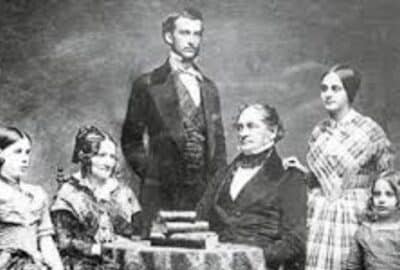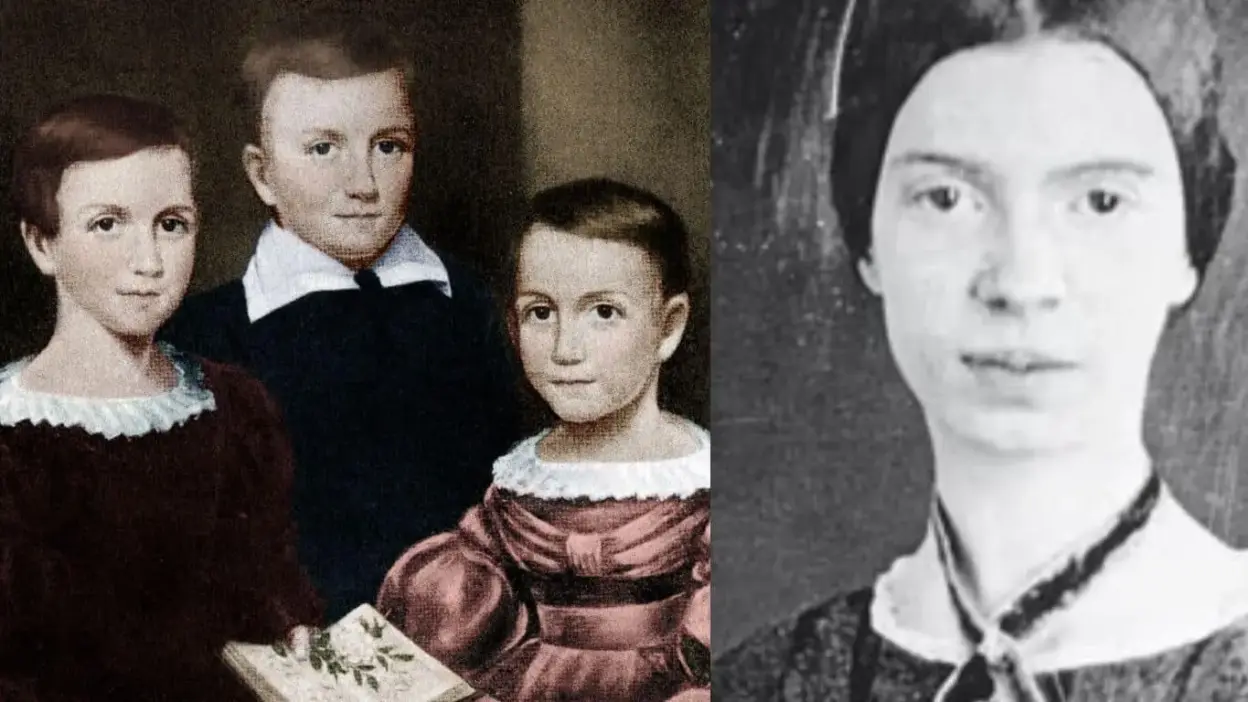Emily Dickinson Biography: Emily Dickinson, born in 1830, was an American poet whose enigmatic life and revolutionary work have cemented her as one of the most important figures in American literature. Living much of her life in seclusion in Amherst, Massachusetts, Dickinson penned nearly 1,800 poems, exploring profound themes such as death, love, and the human psyche. While only a handful of her works were published during her lifetime—often anonymously or without her consent—her posthumous collections have garnered critical acclaim and a dedicated following.
Her unique stylistic choices, such as unconventional punctuation and short lines, have sparked extensive scholarly analysis. This article delves into Dickinson’s intriguing life, her unpublished oeuvre, and the lasting impact she has had on literature and culture.
Emily Dickinson Biography | Life, Books and Facts
Early Life

Emily Elizabeth Dickinson was born on December 10, 1830, in Amherst, Massachusetts, into a family of prominence and affluence. She was the middle child of Edward Dickinson, a successful lawyer and politician, and Emily Norcross Dickinson, who was often bedridden with various ailments. Raised alongside an older brother, William Austin, and a younger sister, Lavinia, Emily grew up in a household that valued education and religious piety. She initially attended the co-educational Amherst Academy, where she received a broad education in subjects ranging from English and Latin to history and arithmetic.
Though she was known to be a bright and diligent student, her time at Mount Holyoke Female Seminary was cut short; she attended for only one year before returning home for reasons not entirely clear but often attributed to homesickness, her mother’s poor health, or perhaps her own emotional discomfort with the school’s evangelical religious environment. These formative years laid the groundwork for Dickinson’s later reclusive lifestyle and intense literary pursuits. They were also a time when she began to manifest a sensitive, introverted temperament and an inclination toward solitude—a trait that would significantly shape both her life and her groundbreaking poetic work.
Family and Relationships

Emily Dickinson’s family life and relationships were complex and had a significant impact on her writing and reclusive nature. The Dickinson family was prominent in Amherst, Massachusetts, which played a role in both supporting and constraining her.
Immediate Family
- Father, Edward Dickinson: A prominent lawyer and politician, he was a stern figure but also supportive of his daughter’s education. However, he was not supportive of her publishing her poetry, preferring that she focus on domestic responsibilities.
- Mother, Emily Norcross Dickinson: Often in poor health, her mother was not as emotionally available as might be typical. Nevertheless, Dickinson was close to her mother and took on domestic responsibilities, especially in her later years.
- Brother, William Austin Dickinson: Also known as Austin, he was an attorney like their father. Dickinson was close to Austin, but their relationship was strained by Austin’s troubled marriage and extramarital affair.
- Sister, Lavinia Dickinson: Known as “Vinnie,” she was Emily’s closest confidante and the one who discovered her trove of nearly 1,800 poems after her death. Vinnie made it her mission to get Emily’s poems published posthumously.
Relationships and Friendships
- Thomas Wentworth Higginson: A critic and editor, Higginson was one of Dickinson’s mentors. She initiated contact with him, and they corresponded for many years. However, they met in person only twice.
- Susan Gilbert Dickinson: Susan, who married Austin, was Emily’s close friend and possibly an emotional and intellectual companion. The relationship was intricate and has been the subject of much speculation and debate among scholars.
- Mabel Loomis Todd: An editor and close acquaintance of Emily’s brother, Austin. She never met Emily but played a crucial role in getting her works published posthumously. Her involvement was both celebrated and criticized, given her extramarital affair with Austin.
- Samuel Bowles: Editor of the Springfield Republican, a newspaper, and a family friend. Dickinson admired him and they maintained a correspondence. He published a few of her poems, although they were usually edited heavily to fit conventional styles.
Dickinson’s relationships were primarily maintained through correspondence. While she became increasingly reclusive in her later years, these relationships served as vital connections to the outside world and were important emotional and intellectual outlets for her.
Literary Life

Emily Dickinson’s literary life was an enigma much like the poet herself. Though she penned nearly 1,800 poems, only a handful were published during her lifetime, often without her consent and sometimes anonymously. Her reluctance to publish is a subject of much scholarly debate. Regardless, her literary existence was intense, punctuated by her keen reading habits, prolific writing, and correspondence with several intellectual figures of her time.
Writing Style and Innovations
Dickinson’s work is noted for its experimental structure, unconventional punctuation, and brevity. Her poems often employ slant rhyme and unusual syntax. They can be both elusive and direct, employing metaphor and allegory to delve into complex topics like death, love, and existentialism.
Major Themes
- Death and Immortality: Dickinson wrote about death from various perspectives, sometimes personifying it, and at other times, presenting it as an enigma.
- Nature: Many of her poems engage with the natural world to explore broader themes like beauty, transformation, and the mysteries of existence.
- Isolation and Society: As a recluse, Dickinson often pondered the human condition in solitude, exploring the tension between the self and society.
Influences
Dickinson was an avid reader and was influenced by the Bible, Shakespeare, and the works of contemporary authors like Ralph Waldo Emerson and Elizabeth Barrett Browning. She was also influenced by the Romantic and Transcendentalist movements.
Notable Works
- “Because I could not stop for Death”
- “I heard a Fly buzz—when I died”
- “Hope is the thing with feathers”
- “I dwell in Possibility”
Correspondence
Though she had few face-to-face interactions in her later years, Dickinson had an active epistolary life, corresponding with several intellectual figures like Thomas Wentworth Higginson and Samuel Bowles. These letters were not just personal but often contained poems and discussed literary and philosophical topics.
Posthumous Recognition
After her death on May 15, 1886, her sister Lavinia discovered her cache of poems. Despite the complexities surrounding their publication—many were initially heavily edited to fit the poetic conventions of the time—Dickinson’s works grew in popularity and critical acclaim throughout the 20th century and into the 21st. Today, she is considered one of the most important figures in American poetry, and her works are studied worldwide.
Emily Dickinson’s literary life was one of deep introspection, radical experimentation, and profound impact, making her one of the most intriguing and enduring poets in the American canon.
Books and Collections

Emily Dickinson did not publish any books during her lifetime; her work primarily existed as handwritten manuscripts. After her death, however, various editors undertook the task of organizing, editing, and publishing her poetry. Here are some key books and collections that feature her work:
Early Collections
- “Poems by Emily Dickinson” (1890): Edited by Mabel Loomis Todd and Thomas Wentworth Higginson, this was the first collection of Dickinson’s work to be published. It included just over a hundred poems and introduced her to a wider audience, although it was heavily edited to conform to the poetic norms of the time.
- “Poems: Second Series” (1891) and “Poems: Third Series” (1896): These were subsequent volumes that followed the first, also edited by Todd and Higginson. Each volume included additional poems but also continued the practice of editorial alterations.
Letters
- “The Letters of Emily Dickinson” (1958): Edited by Thomas H. Johnson, this comprehensive collection presents her correspondence, offering a window into her private world, her thoughts, and her creative process.
Scholarly Editions
- “The Poems of Emily Dickinson: Variorum Edition” (1998): Edited by R. W. Franklin, this edition is one of the most comprehensive scholarly works, presenting the poems in their original form, unaltered by the earlier editorial changes.
- “Emily Dickinson: The Gorgeous Nothings” (2012): This edition presents facsimiles of Dickinson’s original manuscripts, allowing readers to see her work in its original handwritten form, complete with her characteristic dashes and unconventional punctuation.
- “Emily Dickinson’s Poems: As She Preserved Them” (2016): Edited by Cristanne Miller, this edition aims to present the poems as Dickinson herself had organized and copied them into her fascicles—small booklets made of folded sheets.
Other Notable Collections
- “The Belle of Amherst” (1976): This is not a book by Dickinson but a one-woman play by William Luce, which is based on her life and work. It won several awards and significantly contributed to popular interest in Dickinson.
Digital Archives
In addition to printed collections, Dickinson’s work is also available in various digital archives that aim to present her work unaltered and in the form closest to her original manuscripts.
These posthumous publications and collections have played a pivotal role in establishing Emily Dickinson’s legacy as a titan of American literature. Despite the varying degrees of editorial intervention across editions, the core of her revolutionary poetic voice has endured, captivating readers and scholars alike.
Legacy

The legacy of Emily Dickinson is expansive and enduring, making her one of the most influential figures in American literature. While she lived much of her life in seclusion and had only a handful of poems published during her lifetime, her posthumous impact has been profound.
The Emily Dickinson Museum
The Emily Dickinson Museum in Amherst, Massachusetts, includes the Homestead, where Dickinson was born and lived most of her life, and the adjacent Evergreens, home of her brother Austin. The museum is a pilgrimage site for scholars and fans alike, preserving both the domestic space where she wrote and the broader context of her life.
Academic Recognition
Dickinson’s work is the subject of extensive academic study and is included in the curricula of schools and universities worldwide. Her poems serve as fertile ground for a wide array of scholarly disciplines, including literature, gender studies, and theology.
Literary Influence
Emily Dickinson has had a significant and lasting impact on American literature and poetry. Her experimental style and themes have influenced a wide array of poets and writers, both in the United States and globally, setting her apart as an innovator in her field.
Feminist Icon
While not a feminist in the contemporary sense, Dickinson has become an iconic figure in feminist studies. Her life and work, especially her choice to defy the societal norms of her time, make her an enduring symbol of female independence.
Also Read: 10 Most-Sold Mental Health Books on Amazon So Far



